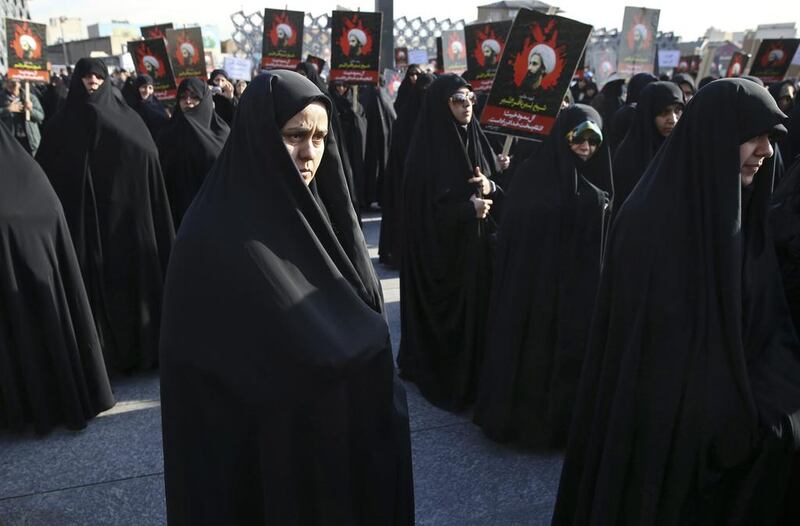For those hoping for greater stability in the Middle East, this has been a discouraging week. The intensified standoff between Saudi Arabia and Iran, backed by their regional allies, is one of the most ominous developments in many months. This is not only a severe fault line between two major regional powers. It also intensifies the sectarianism that increasingly defines regional dynamics and identities, and which threatens to divide the Muslims of the Middle East into bitterly antagonistic rival camps into the foreseeable future.
This current wave of intensification was kicked off by the Saudi execution of a dissident Shia cleric, Nimr Al Nimr, who has repeatedly called for the secession of the oil-rich Eastern Province and was accused of promoting violence in that cause. Nimr was arrested in 2012 and sentenced to death in 2014, but was only executed last week.
The Saudi authorities must have known that this execution would provoke a significant backlash from Iran and many Shia organisations and constituencies in the Arab world.
Moreover, it seems to contradict a number of gestures towards conciliation, including the restoration of full diplomatic relations with Iraq, preparations to send a new ambassador to Iran and substantive discussions with the Iranian officials on the fringes of the Syrian peace talks.
It's likely that the proximate cause for the execution of Nimr and three other Shiite activists was the simultaneous mass execution of more than 40 Sunni extremists associated with Al Qaeda.
Those executions also come in the context of the formation of a Saudi-led antiterrorism alliance and other measures aimed primarily at Sunni radicals such as ISIL and Al Qaeda. The inclusion of a small number of radical Shias in the execution list may well have been an effort to appear “even-handed”, particularly to domestic political constituencies.
Although some claim that Saudi Arabia was acting in a “panicked” manner because many of its policies seem to be going badly, and its economy is in the doldrums, the real message appears to be one of determination and defiance.
Riyadh appears to be telling both Sunni and Shia radicals that they will find little space to operate within the kingdom. Iran and its clients are being put on notice that Saudi Arabia and its allies are not only ready to meet any challenge, but are even prepared to raise the stakes. And the US is being reminded that, given the perceived absence of American leadership, Saudi Arabia is prepared to define its own security measures and pursue its national interests with a much greater degree of independence from Washington.
Many observers, particularly in the West, have reacted angrily to the Saudi move, decrying an apparent sectarian provocation that could only have had the effect of exacerbating Sunni-Shiite tensions. And, indeed, this is what has, predictably, occurred. But what's missing from this analysis is that Riyadh is merely playing catch-up to Tehran.
Iran's sectarian regional politics are so deeply entrenched that no one notices them anymore. They appear to be “normal”. But, of course, they are not. Iran worked for decades to unite Shia and quasi-Shia communities across the Middle East in its orbit, drawing in the Syrian regime, Hizbollah in Lebanon, many of the Shiite parties in Iraq, the Houthis in Yemen and so forth.
Hamas was once the exception that proved the rule, being a Muslim Brotherhood party that was also a part of the pro-Iranian alliance.
However, after the outbreak of the conflict in Syria, Hamas was forced by Damascus and Tehran to choose sides, and it could not remain aligned with what was clearly a sectarian Shia coalition. It was, in effect, expelled from the Iranian alliance because of its opposition to the Bashar Al Assad regime once the Syrian uprising really caught fire.
While it might be fair to decry the exploitation of sectarian sensibilities by both countries, it's preposterous to imply that Saudi Arabia is exacerbating religious divisions without acknowledging that this has been Iran's modus operandi for decades, since at least the outbreak of the Iran-Iraq war, if not from the very outset of the Islamic Republic.
Yet the situation is alarming and dangerous, and there are faults on both sides.
While it is extremely unlikely that there will be a direct military confrontation between Iran and Saudi Arabia, both countries are now involved in directly combating each other's clients.
In Yemen, Saudi Arabia and its allies are directly confronting the Iranian-backed Houthi rebels, while in Syria, Iranian forces have joined with Syrian government, Russian, Hizbollah and even Iraqi militia forces in combating Saudi-backed Syrian rebels.
With the breaking of diplomatic relations with Iran and the suspension of even trade links by Saudi Arabia, following the outrageous attack by government-backed Iranian mobs against the Saudi embassy in Tehran, tensions have reached a new high.
It's in everyone's interests that the parties pull back and resume efforts to create a constructive dialogue. But for that to happen, enlightened self-interest and responsible behaviour are going to have to replace the current atmosphere of mutual fear, suspicion and loathing. Right now, that seems a tall order indeed.
Hussein Ibish is a senior resident scholar at the Arab Gulf States Institute in Washington
On Twitter: @ibishblog





